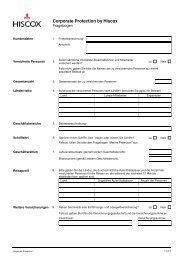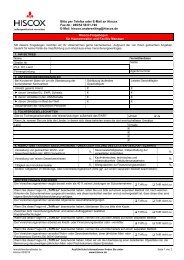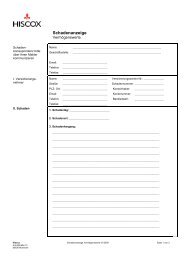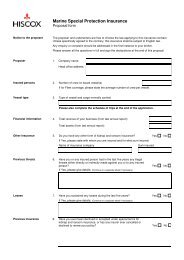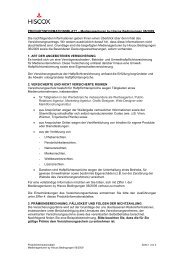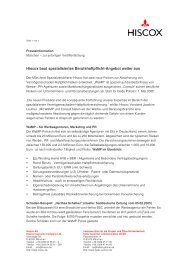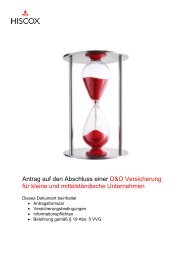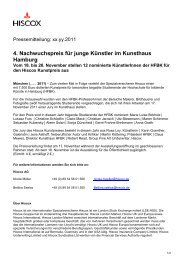Download PDF - Hiscox
Download PDF - Hiscox
Download PDF - Hiscox
You also want an ePaper? Increase the reach of your titles
YUMPU automatically turns print PDFs into web optimized ePapers that Google loves.
Notes to the consolidated<br />
financial statements<br />
continued<br />
2 Significant accounting policies continued<br />
2.13 Insurance contracts continued<br />
(e) Outwards reinsurance contracts<br />
held continued<br />
carrying amount of the reinsurance asset to<br />
its recoverable amount and recognises the<br />
impairment loss in the income statement.<br />
(f) Receivables and payables related<br />
to insurance contracts<br />
Receivables and payables are recognised<br />
when due. These include amounts due<br />
to and from agents, brokers and insurance<br />
contract holders.<br />
If there is objective evidence that the<br />
insurance receivable is impaired, the<br />
Group reduces the carrying amount of<br />
the insurance receivable accordingly and<br />
recognises the impairment loss in profit<br />
or loss.<br />
(g) Salvage and subrogation<br />
reimbursements<br />
Some insurance contracts permit the Group<br />
to sell property acquired in settling a claim<br />
(i.e. salvage). The Group may also have the<br />
right to pursue third-parties for payment of<br />
some or all costs (i.e. subrogation). Estimates<br />
of salvage recoveries are included as an<br />
allowance in the measurement of the<br />
insurance liability for claims and salvage<br />
property is recognised in other assets when<br />
the liability is settled. The allowance is the<br />
amount that can reasonably be recovered<br />
from the disposal of the property.<br />
Subrogation reimbursements are also<br />
considered as an allowance in the<br />
measurement of the insurance liability for<br />
claims and are recognised in other assets<br />
when the liability is settled. The allowance<br />
is the assessment of the amount that can<br />
be recovered from the action against the<br />
liable third-party.<br />
2.14 Deferred tax<br />
Deferred tax is provided in full, using the<br />
liability method, on temporary differences<br />
arising between the tax bases of assets<br />
and liabilities and their carrying amounts<br />
in the financial statements. However, if<br />
the deferred income tax arises from initial<br />
recognition of an asset or liability in a<br />
transaction other than a business combination<br />
that at the time of the transaction affects<br />
neither accounting nor taxable profit or<br />
loss, it is not recognised. Deferred tax is<br />
determined using tax rates and laws that<br />
have been enacted or substantively enacted<br />
by the balance sheet date and are expected<br />
to apply when the related deferred tax asset<br />
is realised or the deferred tax liability is<br />
settled. Deferred tax assets are recognised<br />
to the extent that it is probable that the<br />
future taxable profit will be available against<br />
which the temporary differences can be<br />
utilised. Deferred tax is provided on temporary<br />
differences arising on investments in<br />
subsidiaries and associates, except where<br />
the Group controls the timing of the reversal<br />
of the temporary difference and it is<br />
probable that the temporary difference<br />
will not reverse in the foreseeable future.<br />
2.15 Employee benefits<br />
(a) Pension obligations<br />
The Group operated both defined<br />
contribution and defined benefit pension<br />
schemes during the year under review.<br />
The defined benefit scheme closed to<br />
future accrual with effect from 31 December<br />
2006 and active members were offered<br />
membership of the defined contribution<br />
scheme from 1 January 2007.<br />
A defined contribution plan is a pension<br />
plan under which the Group pays fixed<br />
contributions into a separate entity and has<br />
no further obligation beyond the agreed<br />
contribution rate. A defined benefit plan<br />
is a pension plan that defines an amount<br />
of pension benefit that an employee will<br />
receive on retirement, usually dependent<br />
on one or more factors such as age, years<br />
of service and compensation.<br />
For defined contribution plans, the Group<br />
pays contributions to publicly or privately<br />
administered pension insurance plans<br />
on a contractual basis. The contributions<br />
are recognised as an employee benefit<br />
expense when they are due. Prepaid<br />
contributions are recognised as an asset<br />
to the extent that a cash refund or a<br />
reduction in future payments is available.<br />
The amount recognised in the balance sheet<br />
in respect of defined benefit pension plans<br />
is the present value of the defined benefit<br />
obligation at the balance sheet date less<br />
the fair value of plan assets, together with<br />
adjustments for unrecognised actuarial gains<br />
or losses and past service costs. Plan assets<br />
exclude any insurance contracts issued<br />
by the Group. To the extent that a surplus<br />
emerges on the defined benefit obligation,<br />
it is only recognisable on the asset side of the<br />
balance sheet when it is probable that future<br />
economic benefits will be recovered by the<br />
scheme sponsor in the form of refunds or<br />
reduced future contributions.<br />
Actuarial gains and losses are only<br />
recognised when the net cumulative<br />
58 Notes to the consolidated financial statements <strong>Hiscox</strong> Ltd Report and Accounts 2009<br />
unrecognised actuarial gains and losses<br />
for each individual plan at the end of the<br />
previous accounting period exceeds<br />
10% of the higher of the defined benefit<br />
obligation and the fair value of the plan<br />
assets at that date. Such actuarial gains<br />
or losses falling outside of this 10% corridor<br />
are charged or credited to income over the<br />
employees’ expected average remaining<br />
working lives.<br />
Past service costs are recognised<br />
immediately in income, unless the changes<br />
to the pension plan are conditional on the<br />
employees remaining in service for a<br />
specified period of time (the vesting period).<br />
In this case, the past service costs are<br />
amortised on a straight-line basis over<br />
the vesting period.<br />
(b) Other long-term employee benefits<br />
The Group provides sabbatical leave to<br />
employees on completion of a minimum<br />
service period of ten years. The present<br />
value of the expected costs of these<br />
benefits is accrued over the period of<br />
employment. In determining this liability,<br />
consideration is given to future increases<br />
in salary levels, experience with employee<br />
departures and periods of service.<br />
(c) Share based compensation<br />
The Group operates a number of<br />
equity settled share based employee<br />
compensation plans. These include both<br />
the approved and unapproved share option<br />
schemes, and the Group’s performance<br />
share plans, outlined in the Directors’<br />
remuneration report together with the<br />
Group’s Save as You Earn (SAYE) schemes.<br />
The fair value of the employee services<br />
received, measured at grant date, in<br />
exchange for the grant of the awards<br />
is recognised as an expense with the<br />
corresponding credit being recorded in<br />
retained earnings within equity. The total<br />
amount to be expensed over the vesting<br />
period is determined by reference to the<br />
fair value of the awards granted, excluding<br />
the impact of any non-market vesting<br />
conditions (e.g. profitability or net asset<br />
growth targets). Non-market vesting<br />
conditions are included in assumptions<br />
about the number of awards that are<br />
expected to become exercisable. At each<br />
balance sheet date, the Group revises<br />
its estimates of the number of awards<br />
that are expected to vest. It recognises<br />
the impact of the revision of original<br />
estimates, if any, in the income statement,<br />
and a corresponding adjustment to equity,<br />
over the remaining vesting period.<br />
When the terms and conditions of an<br />
equity settled share based employee




